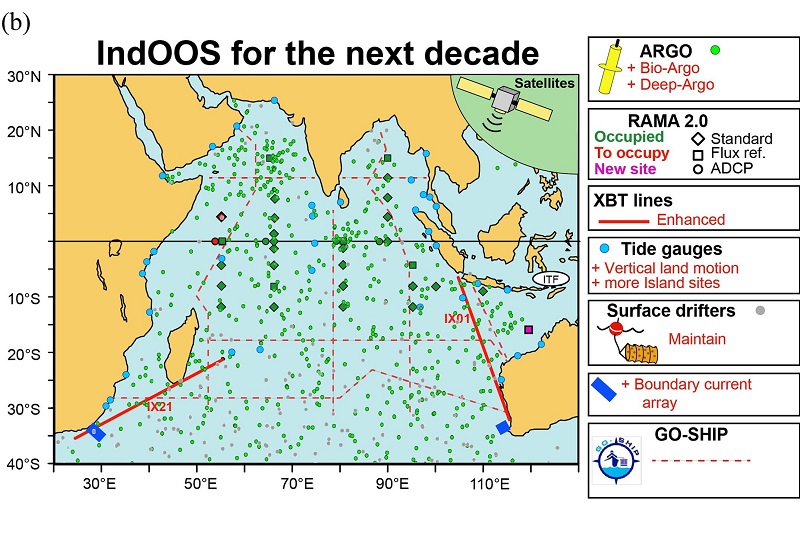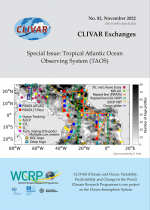A Sustained Ocean Observing System in the Indian Ocean for Climate Related Scientific Knowledge and Societal Needs

The Indian Ocean is warming faster than any of the global oceans and its climate is uniquely driven by the presence of a landmass at low latitudes, which causes monsoonal winds and reversing currents. The food, water, and energy security in the Indian Ocean rim countries and islands are intrinsically tied to its climate, with marine environmental goods and services, as well as trade within the basin, underpinning their economies. Hence, there are a range of societal needs for Indian Ocean observation arising from the influence of regional phenomena and climate change on, for instance, marine ecosystems, monsoon rains, and sea-level. The Indian Ocean Observing System (IndOOS), is a sustained observing system that monitors basin-scale ocean-atmosphere conditions, while providing flexibility in terms of emerging technologies and scientific and societal needs, and a framework for more regional and coastal monitoring.
An article on 'A Sustained Ocean Observing System in the Indian Ocean for Climate Related Scientific Knowledge and Societal Needs' has recently been published in Frontiers in Marine Science, as one of the contributions to the 'OceanObs'19: An Ocean of Opportunity'. This paper includes some of the preliminary findings from the IndOOS Decadal Review, due out in August 2019, led by the CLIVAR/IOC-GOOS Indian Ocean Region Panel (IORP) in collaboration with SIBER. The article discusses the need for continuation of the core part of IndOOS as well as enhanced coastal, shelf, and regional observations. The challenges of sustainability and implementation are also addressed, including capacity building, best practices, and integration of resources. The utility of IndOOS ultimately depends on the identification of, and engagement with, end-users and decision-makers and on the practical accessibility and transparency of data for a range of products and for decision-making processes. Therefore the article highlights the current progress, issues and challenges related to end user engagement with IndOOS, as well as the needs of the data assimilation and modeling communities. Knowledge of the status of the Indian Ocean climate and ecosystems and predictability of its future, depends on a wide range of socio-economic and environmental data, a significant part of which is provided by IndOOS.
**************************************
A Sustained Ocean Observing System in the Indian Ocean for Climate Related Scientific Knowledge and Societal Needs
Front. Mar. Sci., 28 June 2019 | https://doi.org/10.3389/fmars.2019.00355
J. C. Hermes1,2*, Y. Masumoto3,4, L. M. Beal5, M. K. Roxy6,7, J. Vialard8, M. Andres9, H. Annamalai10, S. Behera4, N. D’Adamo11, T. Doi4, M. Feng12, W. Han13, N. Hardman-Mountford14, H. Hendon15, R. Hood16, S. Kido3, C. Lee17, T. Lee18, M. Lengaigne8, J. Li19, R. Lumpkin20, K. N. Navaneeth21, B. Milligan22, M. J. McPhaden7, M. Ravichandran23, T. Shinoda24, A. Singh25, B. Sloyan12, P. G. Strutton26,27, A. C. Subramanian28, S. Thurston18, T. Tozuka3, C. C. Ummenhofer9, A. S. Unnikrishnan29, R. Venkatesan21, D. Wang30, J. Wiggert31, L. Yu9 and W. Yu32
1 Egagasini Node, The South African Environmental Observation Network, Cape Town, South Africa
2 Department of Oceanography, University of Cape Town, Cape Town, South Africa
3 Department of Earth and Planetary Science, Graduate School of Science, The University of Tokyo, Tokyo, Japan
4 Application Laboratory, Japan Agency for Marine-Earth Science and Technology, Yokosuka, Japan
5 Rosenstiel School of Marine and Atmospheric Science, University of Miami, Miami, FL, United States
6 Indian Institute of Tropical Meteorology, Pune, India
7 Pacific Marine Environmental Laboratory (NOAA), Seattle, WA, United States
8 Sorbonne Universités (UPMC, Univ Paris 06)-CNRS-IRD-MNHN, LOCEAN Laboratory, IPSL, Paris, France
9 Department of Physical Oceanography, Woods Hole Oceanographic Institution, Woods Hole, MA, United States
10 International Pacific Research Center, University of Hawaii, Honolulu, HI, United States
11 Intergovernmental Oceanographic Commission of UNESCO (IOC-UNESCO), Paris, France
12 Commonwealth Scientific and Industrial Research Organisation (CSIRO), Oceans and Atmosphere, Centre for Southern Hemisphere Oceans Research, Hobart, TAS, Australia
13 Department of Atmospheric and Oceanic Sciences, University of Colorado, Boulder, Boulder, CO, United States
14 Trade, Oceans and Natural Resources, Commonwealth Secretariat, London, United Kingdom
15 Bureau of Meteorology, Melbourne, VIC, Australia
16 Center for Environmental Science, University of Maryland, Cambridge, MD, United States
17 Applied Physics Laboratory, University of Washington, Seattle, WA, United States
18 Jet Propulsion Laboratory, NASA, Washington, DC, United States
19 International CLIVAR Project Office (ICPO), Qingdao, China
20 Atlantic Oceanographic and Meteorological Laboratory (NOAA), Miami, FL, United States
21 National Institute of Ocean Technology, Chennai, India
22 Faculty of Law, University of New South Wales, Sydney, NSW, Australia
23 National Centre for Antarctic and Ocean Research, Goa, India
24 Department of Physical and Environmental Sciences, Texas A&M University–Corpus Christi, Corpus Christi, TX, United States
25 Physical Research Laboratory, Ahmedabad, India
26 Institute for Marine and Antarctic Studies, University of Tasmania, Hobart, TAS, Australia
27 Australian Research Council Centre of Excellence for Climate Extremes, University of Tasmania, Hobart, TAS, Australia
28 Scripps Institution of Oceanography, University of California, San Diego, La Jolla, CA, United States
29 National Institute of Oceanography (CSIR), Dona Paula, India
30 South China Sea Institute of Oceanology (CAS), Guangzhou, China
31 Division of Marine Science, The University of Southern Mississippi, John C. Stennis Space Center, Hancock County, MS, United States
32 First Institute of Oceanography, State Oceanic Administration, Qingdao, China













